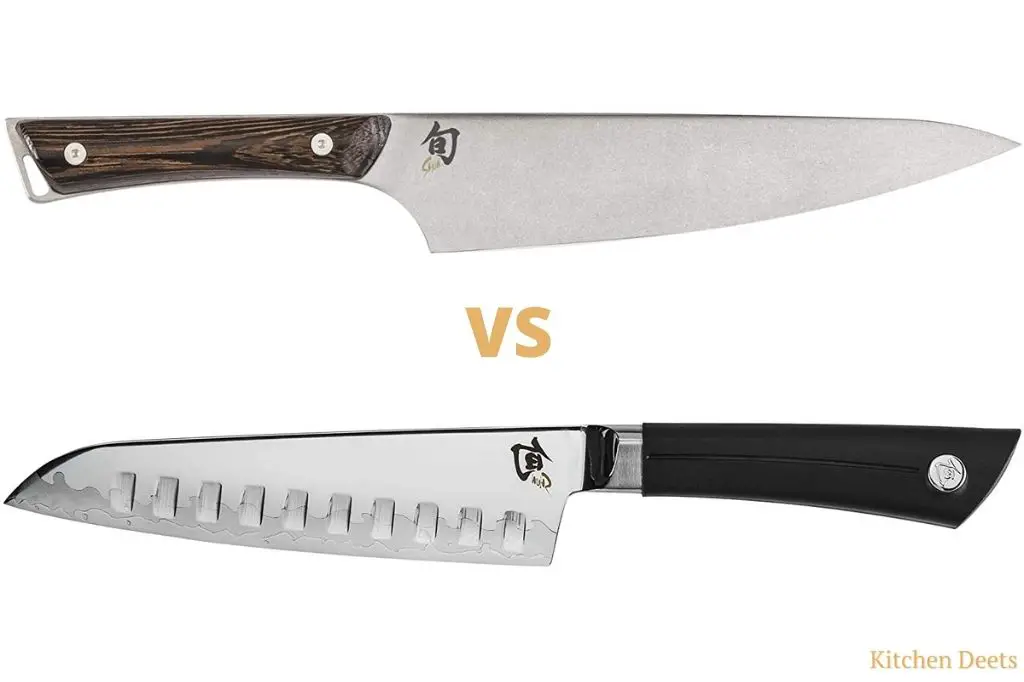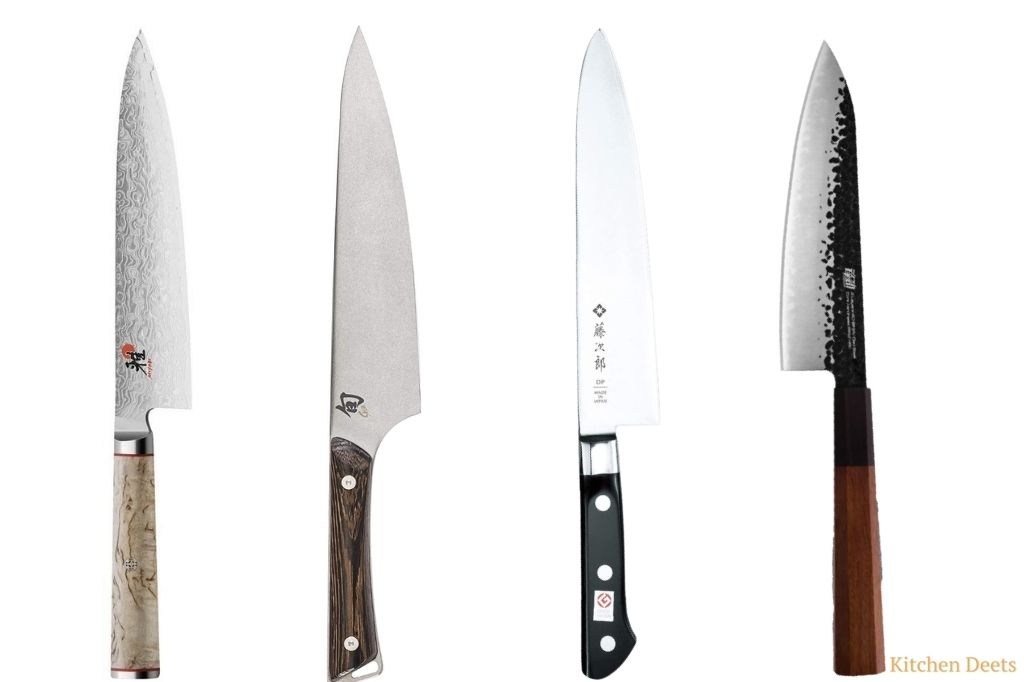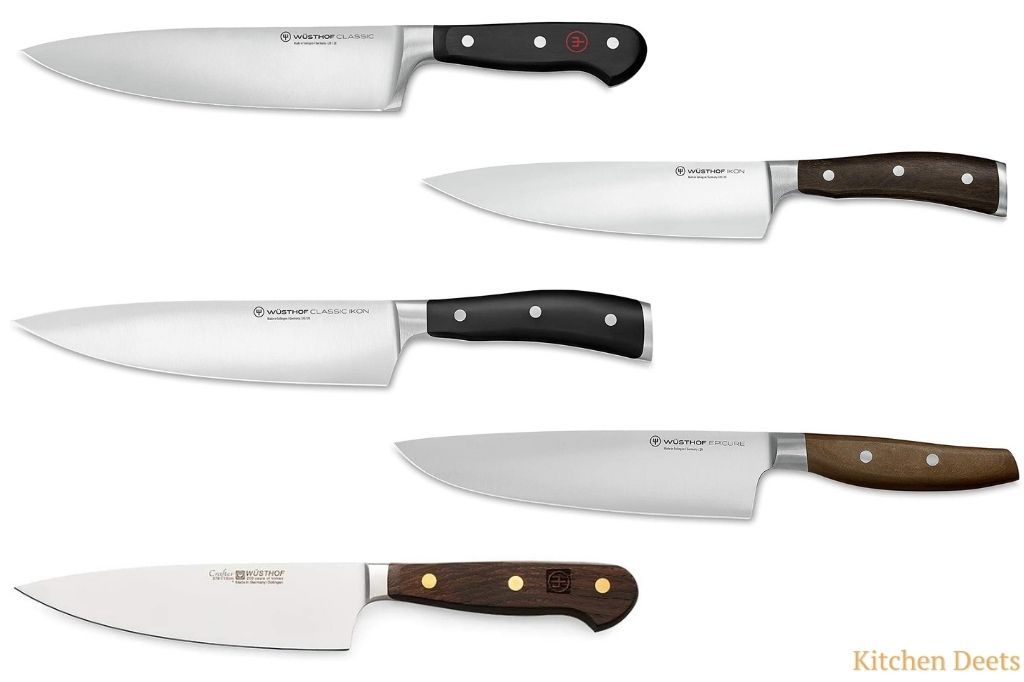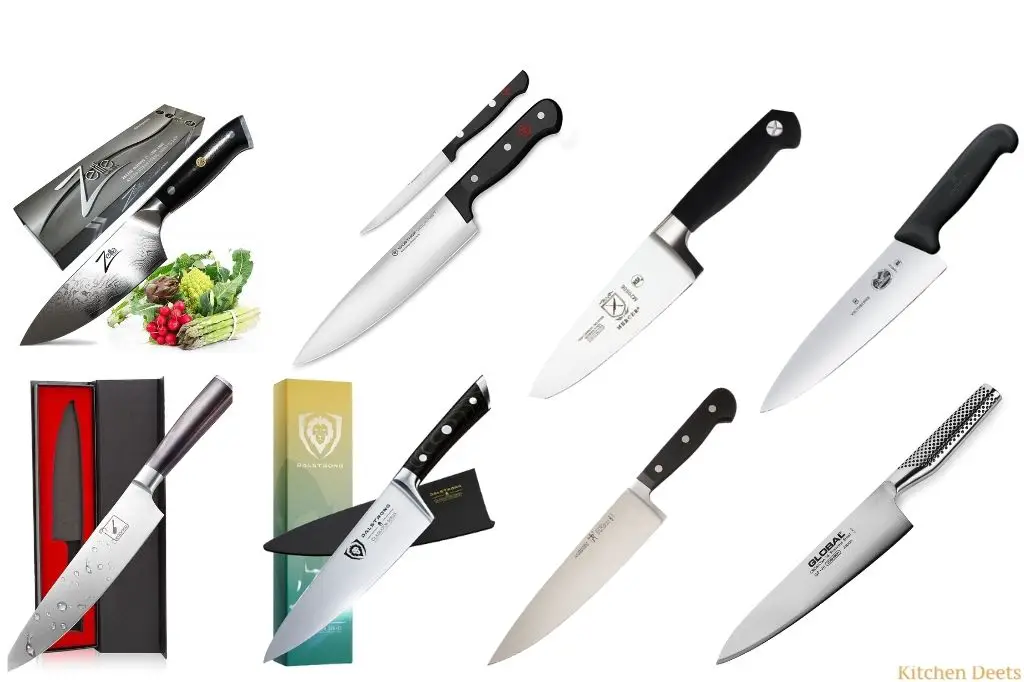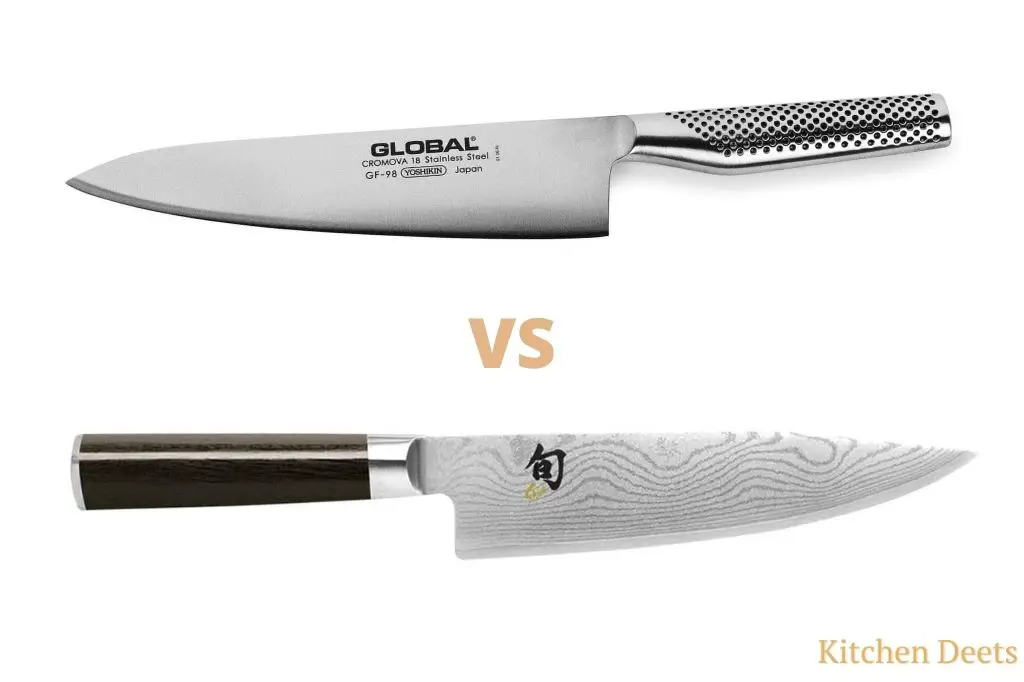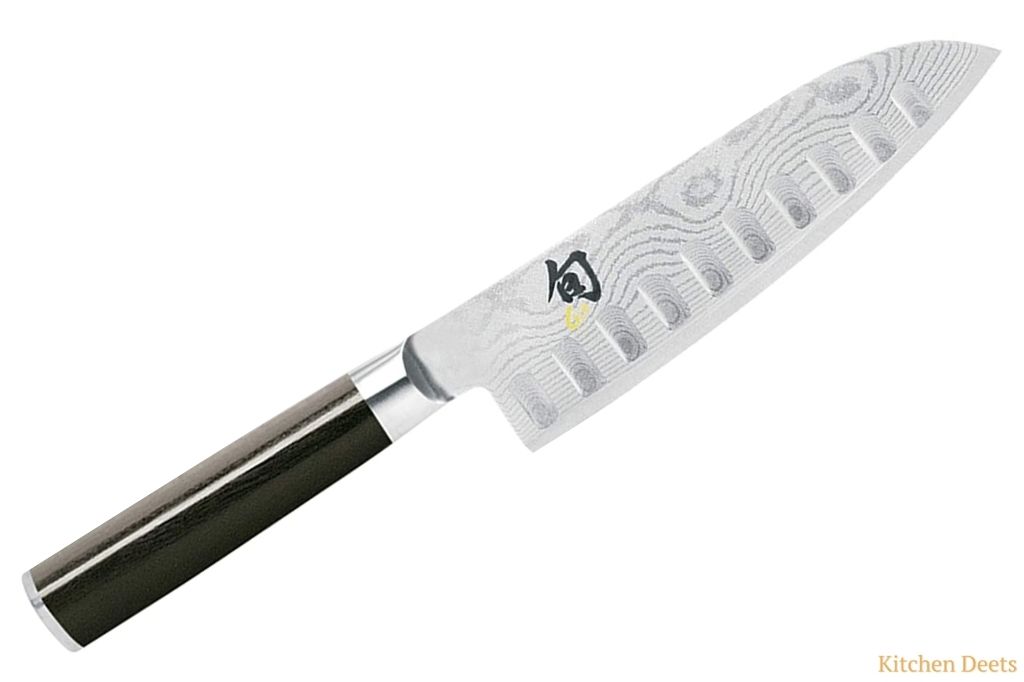You may have heard of the terms Gyuto knife and Santoku knife being thrown around in kitchen conversations, but do you know the differences between these two types of knives? There are several differences between Gyuto knives and Santoku knives that you should be aware of before buying either knife to be sure it’s the right fit for your cooking style.
A gyuto knife and a santoku knife are both Japanese chef knives. These knives, with their cutting blades and wooden handles, can cut through most types of vegetables and meats without any problems.
Both of these styles of knives are similar in size and shape, so you might be wondering what sets them apart.
Today, we’ll go over the major differences between Gyuto knives and Santoku knives. So you can learn all about these two types of Japanese knives.
Gyuto Knife, Advantages and Limitations:

The word “gyuto” is Japanese for cow sword or beef sword, but in reference to kitchen knives, it describes an Asian-style chef knife. While there are several different types of Gyutos (and even specific brands that claim to have patented designs), they all share certain similarities—they tend to be longer than Santokus, with straighter edges that taper toward their tips.
Gyuto knives range from 6-10 inches in length in western measure. Generally, the shorter ones are used by the butchers. The longer ones are preferred by chefs for slicing meat or miscellaneous things. The point would be rounded out similarly to western chef knives except that the Japanese ones have sharper edges so they can get more cut on each stroke without being damaged.
These knives have less belly and a thicker blade that gives it a good balance and is optimized for de-boning (removing excess meat), cutting up vegetables, or using for basic cuts. However, when you’re working with a lot of protein (meat and fish). I would recommend having a set of santoku knives.
Check out our article on Carving vs Chef Knife
Advantages:
Best chef knife for slicing meat.
Easily chops vegetables.
Perfect for removing excess meat.
Good for rock chopping.
The Japanese version of Western-style chef knives
Sharper tip for precise cuts.
Most gyuto knives come in double bevels.
Limitations:
Not as efficient as Santoku knives when it comes to slicing, dicing, mincing.
Heavier than Santoku knives.
Santoku Knife, Advantages and Limitations:

Santoku is a Japanese term that literally translates as “three-purpose (knife)”. A santoku knife, also known as a general-purpose kitchen knife, is typically smaller than most western-style chef knives, with a blade length of 7 inches or less. It is ideal for chopping, mincing, dicing, cutting, slicing, and more because it has straight edge that makes it perfect for tasks where you have to work in small areas or tight corners.
It has characteristics of both a Nakiri (Used specifically for cutting vegetables) and a Deba knife (Used for slicing fish).
A Santoku knife features a Granton edge on the blade. Granton edges are hollowed grooves on either side of the blade which provide an air pocket between the blade and food allowing for easy cutting. These knives also feature some sort of bolster that can help prevent your hand from slipping forward onto the blade. Along with that, they are lightweight and thin which makes them good for speed chopping.
Check out our article on Santoku vs Chef Knives
Advantages:
A versatile knife that can also cut through fish.
Lighter in weight as compared to gyuto knives.
Thinner blade as compared to gyuto knives.
Most Santoku knives have hollow edges for easy cutting.
Three-purpose knife “Cutting, slicing, and chopping”.
Affordable in terms of price.
Limitations:
Cannot cut through tough pieces of meat.
Requires proper care.
After use, hand wash and dry immediately with a soft cloth.
Shorter in length.
Chips if used on tough material.
Mostly come in Single bevel.
Check out our article on Nakiri vs Santoku
Santoku vs Gyuto, Differences:
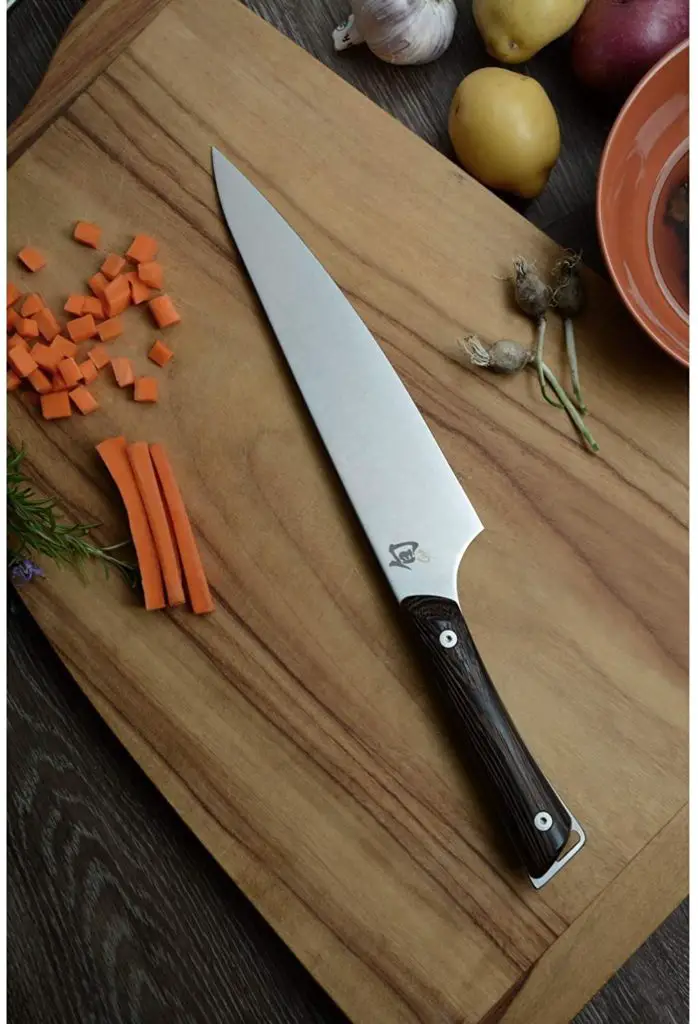
Choosing the right kitchen knife is no easy task. This is especially true if you’re just starting out in the kitchen. With so many types, brands, and sizes of knives available, you can easily become overwhelmed by options. To make matters worse, a lot of experts in the field offer conflicting advice on the matter. Some claim that a santoku is superior to a gyuto, while others insist upon classic European styling. So how does one go about finding the ultimate kitchen knife? Let’s compare them side by side to find out.
Blade:
Gyuto knife has a blade that is designed to be used for all purposes including slicing and dicing tough pieces of meat. A santoku knife, on the other hand, is made specifically for chopping, and mincing vegetables.
Blade Width:
If you’re familiar with Western-style knives, you’ll know that Western-style knives usually have wider blades than Japanese-style knives, which helps to provide stability during blade work. This is also true with gyutos.
Size of Blade:
A santoku knife usually has a 5 to 7-inch blade while a gyuto knife blade can vary from 6 inches to over 10 inches. Although santokus are shorter in blade, this doesn’t necessarily mean they’re not as effective as gyuto knives.
Use of Knives:
If you plan to cook only vegetables, Santokus are the right choice. However, for meat cutting, Gyutos are best.
Weight:
Gyutos tend to be heavier and more substantial as compared to Santoku knives.
Cut through food:
A gyuto knife can cut through food more easily than a santoku knife, as it has a wider blade. The santoku knife on the other hand is lighter and balances better in your hand, making it easier to use for precise cuts.
Steel:
Both knives use high carbon stainless steel such as VG-MAX.
Price:
In terms of price, Gyuto knives are expensive than santoku knives.
Gyuto Vs Santoku Comparison Table:
| Attributes | Santoku Knife | Gyuto Knife |
|---|---|---|
| Origin | In Japan, 1940s | In Japan, 19th to 20th century |
| Best Uses | Slicing, dicing, chopping, and mincing | Cutting, deboning, piercing, slicing, dicing, mincing, and crushing. |
| Cutting Action | Push cutting | Rocking chop |
| Blade Design | Downturned spine, curved blade edge | Flat spine, sharply curved blade edge |
| Steel | VG-MAX | VG-MAX |
| Blade Length | 5-7 inches | 5.5-10 inches |
| Sharpness | Single or double bevel | Double bevel |
| Weight | Lighter than gyuto knives. | Heavier than santoku knives. |
Which Knife Chef Prefers?
Most chefs prefer to have both types of knives in their kitchen. Having one of each will enable you to work with different shapes and weights of food without having to change your technique or muscle memory!
Check out our article on Kiritsuke vs Chef knife
Final Thoughts:
While the Japanese culture has dominated the knife industry for years, there is little awareness that Japanese knives, in fact, provide more benefits than their Western-style counterparts. The Japanese kitchen culture has an outstanding reputation in terms of food preparation and presentation. The reason for this is because it treats the use of kitchen knives as an art form rather than a mere cooking routine or chore.
While both knives are Japanese versions of chef knives, they each serve very different purposes. Choose the knife that’s best for your intended purpose. If you do a lot of prep work for your meals at home, you should invest in a santoku knife. And If you like to cook big roasts and other tough meats, you should purchase a gyuto knife.
